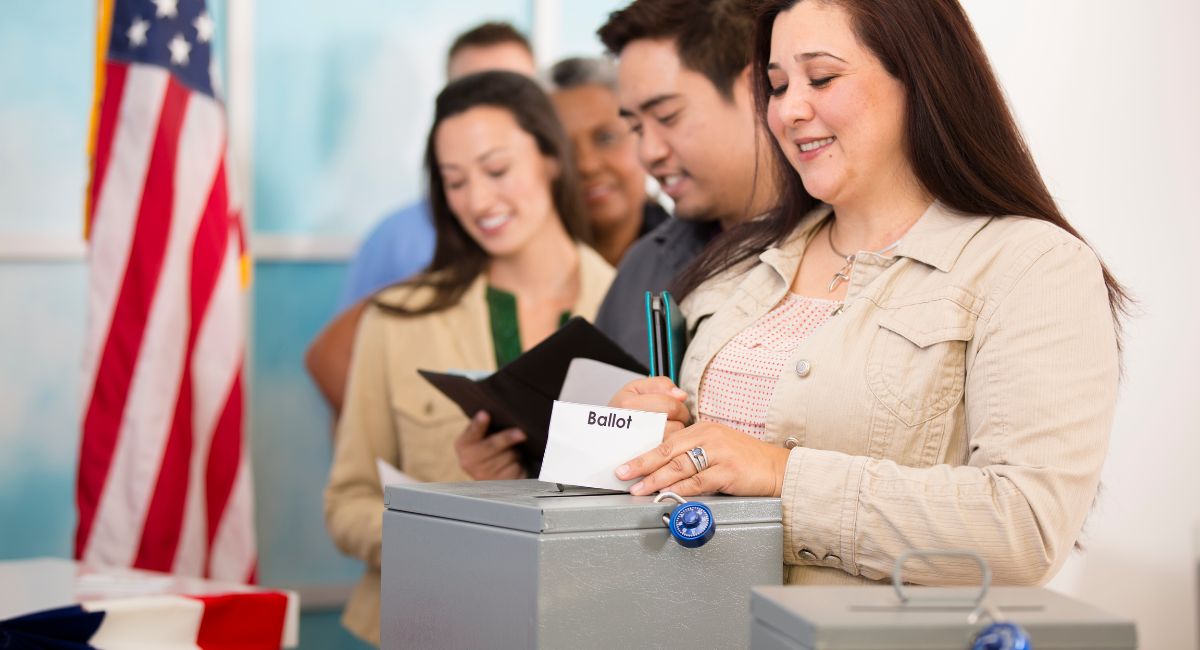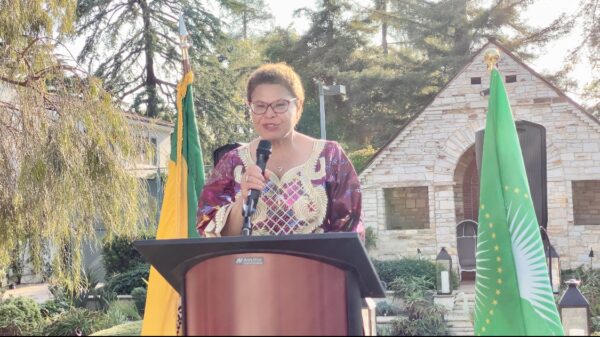Magazine, The Immigrant Experience
In the intricate tapestry of American democracy, a seismic shift is underway as the nation undergoes a demographic transformation. At the heart of this change is the rising influence of ethnic voters, particularly among the burgeoning younger generation. With the nation becoming less homogenous and more diverse, questions about the evolving nature of political affiliations and the impact on electoral dynamics have taken center stage in the ongoing discourse on democracy.
Event Overview:
A series of briefings has been strategically planned to explore and dissect these crucial issues. The inaugural event brought together eminent figures in academia and politics, including Karthick Ramakrishnan, Professor of Public Policy at the University of California, Riverside, and founder of AAPI Data; Claudia Sandoval, Assistant Professor at Loyola Marymount University; Jamil Scott, Assistant Professor at Georgetown University; Jessica Siles, Deputy Press Secretary for Voters of Tomorrow; and Ta’jin Perez, Deputy Director of Western Native Voices.
Insights from Karthick Ramakrishnan’s Presentation:
Professor Ramakrishnan introduced groundbreaking findings derived from the recently launched “Amplify AAPI” panel, a collaborative initiative involving the Associated Press and the University of Chicago. This innovative panel, equipped with language support, facilitates regular monthly surveys, providing unparalleled insights into the perspectives of Asian Americans and Pacific Islanders (AAPI) – a critical demographic in the evolving political landscape.
Key Findings:
Unveiling the intricacies of API attitudes, the presentation highlighted several key findings. Firstly, presidential candidates Joe Biden and Kamala Harris enjoyed majority favorability among API adults, while Donald Trump and Ron DeSantis faced a predominantly unfavorable reception. Notably, opinions on candidates Nikki Haley and Vivek Ramasamy were marked by a prevalence of unfavorable views, emphasizing the significance of informed public perception.
Additionally, the presentation delved into the realm of partisanship, providing detailed insights into the political affiliations of API adults. The discussion also touched upon critical issues of hate crimes and racism, with 86% of APIs acknowledging racism as a serious concern. Disturbingly, a third of API adults reported experiencing various forms of hate incidents, ranging from verbal harassment to racial slurs.
Furthermore, the presentation addressed mental health and anxiety, revealing that a majority of API adults reported good or excellent mental health. However, a notable subset, constituting 12%, fell within the moderate to high-risk category for anxiety.
Conclusion:
As the first in a series of planned briefings, this event set the stage for a comprehensive exploration of the intersection between democracy and the rise of ethnic voters. The data and insights unveiled by Professor Ramakrishnan and his colleagues offer a nuanced understanding of the evolving political landscape, providing a valuable foundation for ongoing discussions on the future of American democracy in the face of demographic change.
Insights from Claudia Sandoval on Latino Voters:
Assistant Professor Claudia Sandoval, specializing in Political Science and International Relations at Loyola Marymount University, sheds light on critical aspects of the Latino electorate. Emphasizing the upcoming 2024 presidential election, she underscores that 22% of Latino eligible voters will cast their ballots for the first time, representing a pivotal moment in shaping political outcomes.
Notably, 38% of the Latino electorate has entered the political sphere since 2016, showcasing a significant influx of new participants. Sandoval draws attention to the substantial increase of 4.7 million eligible Latino voters since 2018, attributing this surge to the demographic impact of young Latinos.
Highlighting the importance of the youth vote, Sandoval dispels common stereotypes by revealing that the median age of young Latino eligible voters is 39, challenging assumptions about the age distribution within the Latino population. Contrary to the perception of Latinos as a recent immigrant population, Sandoval argues that U.S.-born and U.S.-raised Latinos are pivotal in reshaping America’s demographic and political landscape. She provides examples from states like Nevada and Arizona, where the growing influence of young Latino voters has become particularly pronounced.
Sandoval delves into the nuanced shifts in political affiliations, emphasizing that while there may be a marginal increase in support for Republican candidates among Latinos, it doesn’t necessarily indicate a mass exodus to the Republican Party. She points out that historical peaks in Latino support for Republican candidates occurred in 1980, 1984, and 2000, reaching 40% in 2004. Despite recent increases, the Latino vote for Republicans has not yet approached these historical highs.
Moreover, Sandoval explores the gender gaps within the Latino voting bloc, revealing distinct patterns where Latino men, especially in states like Arizona and Texas, show higher support for Republican candidates, including Trump. However, she underscores that these differences don’t necessarily signal a wholesale shift of the Latino vote to the Republican Party.
Intriguingly, Sandoval notes that support for Trump among Latinos may not translate to broad support for the Republican Party. She attributes this phenomenon to perceptions of Trump as an independent figure, with Latinos viewing him distinctively from the overall Republican Party. This nuanced perspective challenges conventional narratives about Latino political preferences.
Sandoval concludes by stressing the complexity of Latino political attitudes, emphasizing that while the majority leans left on policy preferences, Democrats cannot take Latino support for granted. She introduces the critical role of mobilization efforts, urging political parties to invest in grassroots initiatives to tap into the true potential of the Latino vote.
Insights from Jamil Scott on Black Voters:
Assistant Professor Jamil Scott, an expert in Government from Georgetown University, shifts the focus to Black voters and the dynamics shaping their political landscape. Rather than questioning a broad change in partisanship, Scott emphasizes the significance of how well Black voters will turn out on Election Day in 2024.
Scott provides a statistical overview, citing the 92-8% split in favor of Biden among Black non-Hispanic voters in 2020. Acknowledging the gender gap within this demographic, she notes that Black women exhibited overwhelming support for Biden (95%), while Black men showed a slightly lower but still substantial support (87%). Scott explores the nuanced increase in Black voter support for Trump from 6% in 2016 to 8% in 2020, highlighting the dissatisfaction within the Black community towards the Democratic Party.
The professor delves into the complexities of gauging Black voter excitement, emphasizing that tangible accomplishments are vital. While the Biden Administration can tout achievements such as record-low Black unemployment and appointments of Black judges, Scott stresses the importance of legislative promises. Issues like student loan forgiveness and voting rights remain pivotal, and the administration’s ability to fulfill these promises plays a crucial role in Black voter enthusiasm.
Scott echoes the sentiment that Black voters, while dissatisfied with certain aspects of the Democratic Party, may not necessarily alter their partisanship. Instead, the question revolves around the willingness of Black voters to turn out on Election Day, particularly given challenges such as longer wait times in communities of color.
Insights from Jessica Siles on Gen Z Voters:
Jessica Siles, Deputy Press Secretary for Voters of Tomorrow, provides insights into the priorities and characteristics of Generation Z voters. As a Gen Z-led organization, Voters of Tomorrow aims to empower and engage young voters, representing the diverse perspectives within this demographic.
Siles highlights the racial and ethnic diversity of Generation Z, emphasizing its unity and activism on issues such as gun violence prevention, climate action, and abortion rights. She dispels the notion of blind loyalty to any political party, stressing that Gen Z voters align with parties based on core issues rather than unwavering support.
Drawing attention to the increased youth voter turnout, Siles challenges the perception of low engagement by pointing out that Generation Z had the highest turnout for the 18 to 24 age group in 30 years during the 2022 midterm elections. She emphasizes the need for political candidates to meet young voters where they are, both online and on college campuses, to address the information gap and engage with this demographic effectively.
Siles also sheds light on the top issues that resonate with Generation Z, including the economy, abortion rights, climate action, and gun violence prevention. She underscores the importance of understanding the economic concerns of young people, who are workers and taxpayers with genuine worries about housing and job prospects.
In addressing barriers to youth voter engagement, Siles identifies a lack of information and engagement from political candidates as a significant challenge. She advocates for candidates to actively reach out to young voters through various platforms and on college campuses. Overall, Siles provides a nuanced perspective on Generation Z, dispelling stereotypes and emphasizing the importance of addressing their specific concerns and priorities.
#AmericanDemocracy #DemographicShift #EthnicVoters #YouthInfluence #PoliticalLandscape #AAPIInsights #LatinoVote #BlackVoters #GenZPriorities #Election2024 #PoliticalAffiliations #VoterEngagement #DemographicChange #YouthActivism #PolicyPreferences #Vote2024 #InclusivityInPolitics #VoterInsights #PoliticalShifts #DemocracyDiscussion #ElectionAnalysis #DiversityInPolitics #PartisanTrends #YouthTurnout #ElectionInsights #DemographicImpact #PoliticalAttitudes #VoterPerspectives #ElectionDynamics #2024Election











